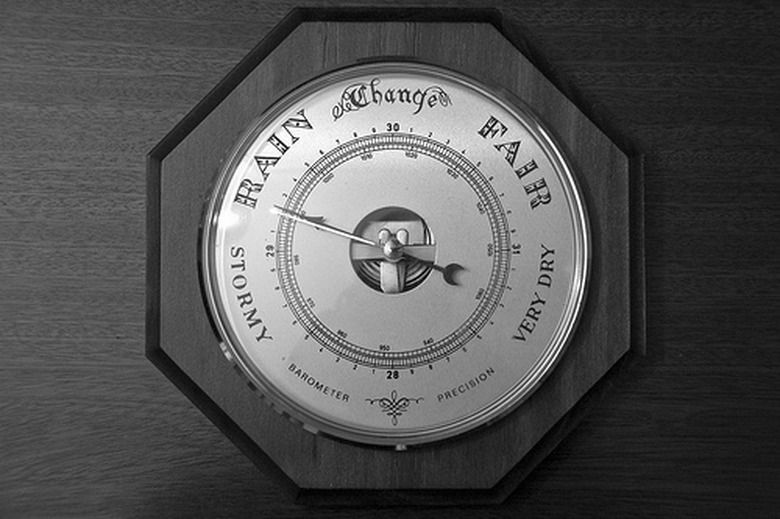How To Understand Barometric Pressure Readings
Barometric pressure (also called atmospheric pressure) is the measure of air pressure in a given area. Air pressure is the weight of air pressing down on a specific area, and it is measured with an instrument called a barometer. These measurements are affected by air density, which changes based on temperature, and height above the Earth's surface. By understanding changes in barometric pressure and what those changes mean, it's possible to predict changes in weather and weather patterns.
Collecting Pressure Measurements
Collecting Pressure Measurements
We can obtain a pressure reading using a barometer, or we can collect the pressure reading on a weather web site or find a weather map that shows areas of high and low pressure. Try to find the exact pressure reading in millibars if possible. Millibars are the measurement of the weight of the atmosphere at a particular location; according to USA Today assistant weather editor Bob Swanson, a standard pressure at sea level is 1013.2 millibars.
TL;DR (Too Long; Didn't Read)
Sometimes pressure is measured in pascals or atmospheres. 1 bar is equivalent to 1,000 hectopascals (hpa) or 100,000 pascals, and 1 atmosphere (atm) is equivalent to 1013.2 millibars.
What does pressure signify?
What does pressure signify?
As air rises, it cools; according to meteorologists with USA Today, "The humidity in [air] begins to condense into tiny drops of water, or if it's cold enough, into tiny ice crystals. If there's enough water or ice, rain or snow begin to fall." Low pressure is often associated with bad weather and high pressure is typically connected with fair weather. These low- and high-pressure systems are crucial to understanding local weather and macroscopic weather systems. Precipitation, wind, and many other weather patterns are very reliant on pressure in the atmosphere.
In meteorology, barometric pressure readings are often a key measurement taken at weather stations. These barometric readings are crucial for weather forecasts and explaining weather conditions. As pressure decreases and increases, it is often an indication of temperature, moving air masses, and high & low pressure systems.
Note the wind speed, as this can also be affected by pressure changes because air moves from high to low pressure areas. This is often a result of convection across temperature gradients. Document the changes in pressure over time and the weather outside and you will be able to more clearly understand how pressure changes can affect and correspond to weather.
Types of Barometers
Types of Barometers
- A mercury barometer measures barometric pressure in inches of mercury (inhg). On average, sea level pressure supports about 30 inches of mercury.
- An aneroid barometer uses mechanical springs to measure atmospheric pressure. Boxes with springs are essentially compressed, and they can then be measured to a known increment.
- Digital barometers often use specific materials with a defined relationship between electricity and applied pressure to provide very accurate measurements of local pressure.
There are many other types of barometers that are often used, but these are some of the most common!
Cite This Article
MLA
Green, David. "How To Understand Barometric Pressure Readings" sciencing.com, https://www.sciencing.com/understand-barometric-pressure-readings-5397464/. 29 March 2023.
APA
Green, David. (2023, March 29). How To Understand Barometric Pressure Readings. sciencing.com. Retrieved from https://www.sciencing.com/understand-barometric-pressure-readings-5397464/
Chicago
Green, David. How To Understand Barometric Pressure Readings last modified March 29, 2023. https://www.sciencing.com/understand-barometric-pressure-readings-5397464/
